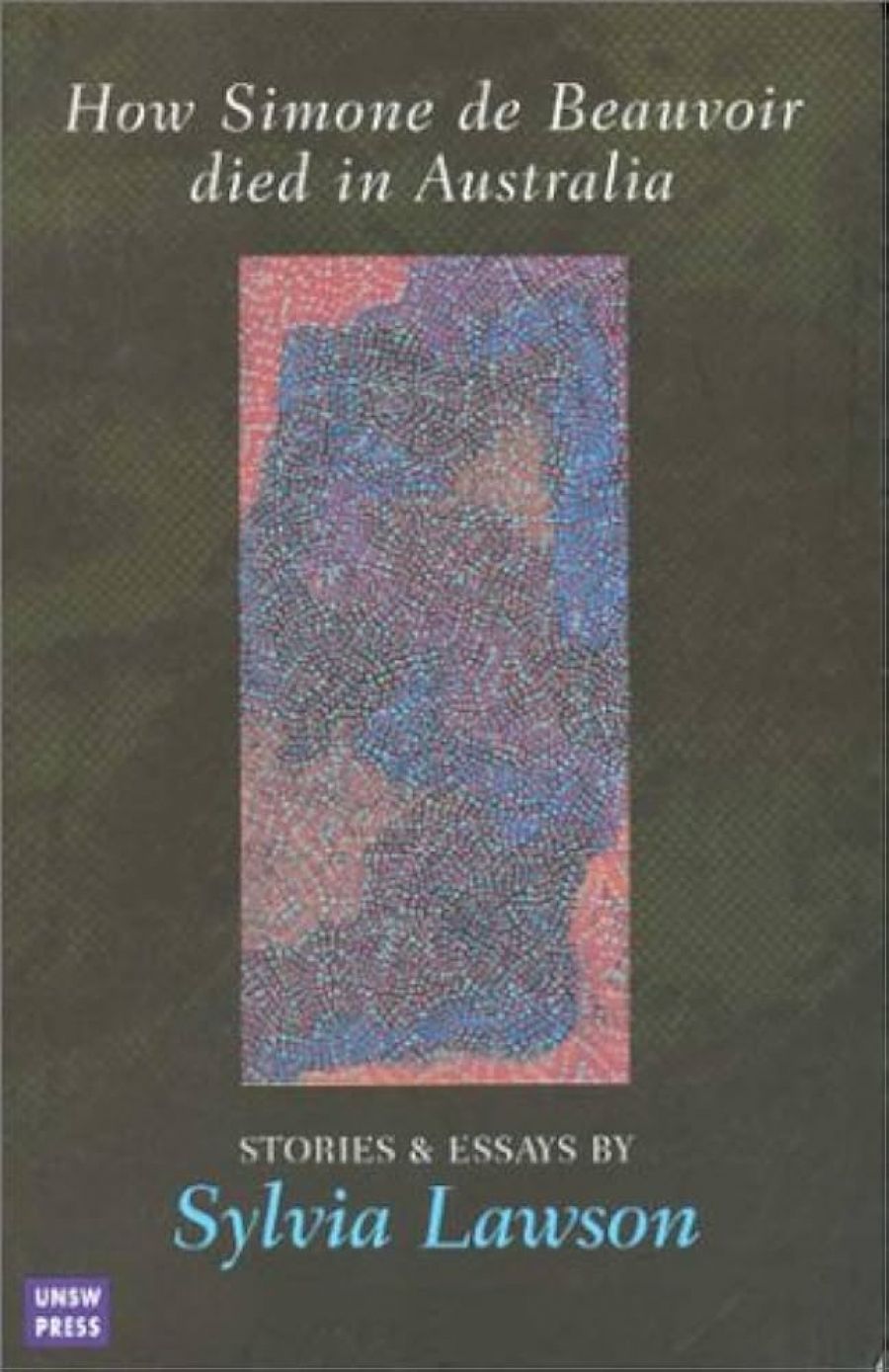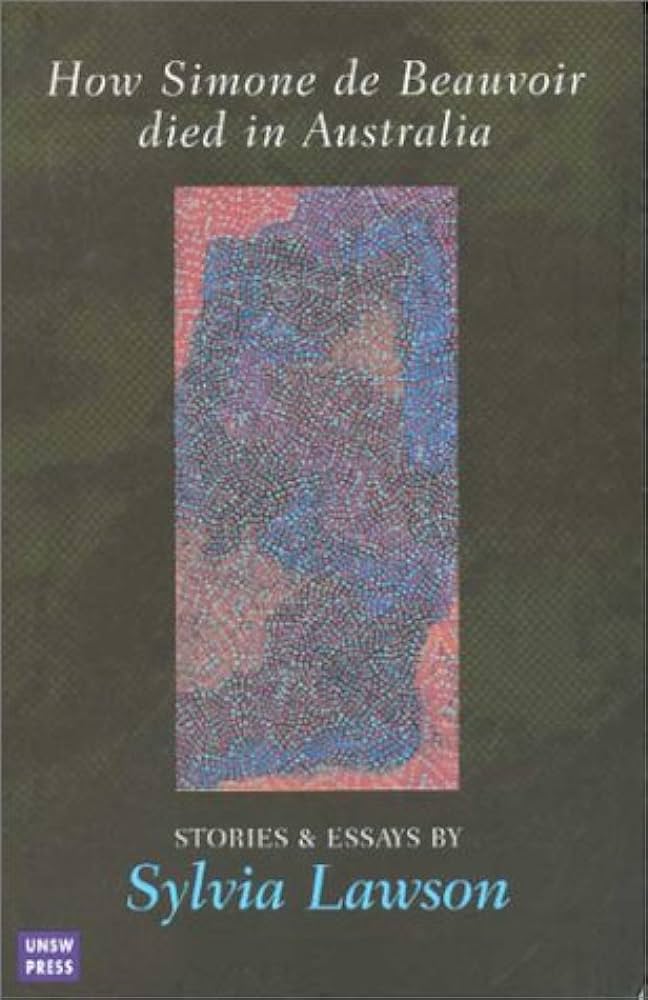
- Free Article: No
- Contents Category: Essay Collection
- Review Article: Yes
- Article Title: Preaching to the Converted?
- Online Only: No
- Custom Highlight Text:
Sylvia Lawson’s How Simone de Beauvoir Died in Australia warrants a second reading to be properly appreciated. The seven pieces in this collection are intricately connected, so that the messages are cumulatively conveyed. The book manifests its author’s ambitious desire to raise the consciousness of her readers. For me, however, the question remains: who is the intended audience?
- Book 1 Title: How Simone de Beauvoir Died in Australia
- Book 1 Subtitle: Stories and essays
- Book 1 Biblio: UNSW Press, $34.95 pb, 208 pp
- Book 1 Cover Small (400 x 600):

- Book 1 Cover (800 x 1200):

The collection, as a whole, is a meticulously researched (and edited) meditation on a number of themes. Foremost amongst these is Australia’s failure to recognise its obligations to its indigenous peoples and its near neighbours in the region, which in turn relates to Australians’ lack of historical awareness. Lawson’s rejection of artificially constructed boundaries, whether between literary genres or such conceptual binaries as ‘local’ versus ‘global’, is also evident, as is her dismay at the relative timidity of the Australian media in straitened times.
Although the pieces are classified as ‘essays and stories’, they are blends of several genres, including journalism, cultural critique, memoir, fiction and literary criticism. Lawson takes as her starting point an exchange between Noam Chomsky and an interviewer, as seen in the documentary Manufacturing Consent (1992). To the question, ‘Do you think the time might come when we might no longer be ashamed of our country?’, Chomsky replied, ‘It depends what you mean by your country.’ Thus readers are immediately put on notice that we will be asked to examine our assumptions about our own country, and perhaps made to feel ashamed. As Lawson asserts: ‘Nothing’s obvious about what it means to be Australian, nothing’s unarguable.’
‘How Raymond Williams died in Australia’ is both an analytical tribute to the legacy of Williams, a formidable advocate of cultural democracy, and a post-mortem of the bicentennial celebrations of the First Fleet’s arrival. That Williams died on 26 January 1988 was, Lawson implies, both fitting and ironic. Living in England during the late-1980s, I missed what some derided as ‘The Masturbation of a Nation’, so Lawson’s observations upon the bicentenary events – including the sheer pervasiveness of associated paraphernalia and imagery, and the logistical and symbolic triumph of the Aboriginal march of protest – were instructive.
The brief story ‘Putting the books away with Jack’ gives the impression of being at least partly autobiographical. The narrator is attempting to sort and shelve her vast collection of books, with the assistance of her twenty-something son. This activity leads to a discussion of how books might satisfactorily be sorted (by author’s nationality? geographical region? discipline or subject area? genre?), which in turn leads to the broader question of whether knowledge can be categorised. The next day, the narrator presents herself for a job interview, but is unsuccessful because ‘your background is in literature, is it not? And this position really is for an historian.’
The following piece, ‘Sidelined – but not entirely lost in translation’, is primarily a discussion of media censorship in Indonesia and of the response of the Australian press to the most repressive instances. The main focus is on the writings of the poet Goenewan Mohamad, co-founder and editor of the journal Tempo, whose oeuvre is apparently something of a model for Lawson: ‘Goenewan throws a double challenge to our categories: to the boundaries of institutionalised literature, and to those of journalistic practice. His essays fulfil the old marvellous dream of Jean-Paul Sartre: this is, par excellence, la littérature engagée, best translated as “committed writing”.’
In the title piece, the longest in the collection, a fictional group of women, of diverse ages and backgrounds, meets regularly in 1999 to discuss Simone de Beauvoir’s works, in honour of the fiftieth anniversary of the publication of The Second Sex. The main narrative, concerning their conversations about the meaning of de Beauvoir’s life and works for Australian women, is interspersed with the narrator’s recollections of her female friends, other young mothers, in the 1960s. Whilst it is in some ways a virtuoso performance, at moments I found it alienating. Late in the piece, some of the women are crying together in front of the television as they watch reports of the violence that erupted in East Timor after the independence ballot. At that point, I felt only impatience with them, suspecting that we are meant to take the public weeping as proof of the women’s exemplary citizenship, rather than of self-indulgence.
This is, of course, unfair to Lawson, whose own sincerity and engagement are not to be doubted. But it pertains to my uncertainty, mentioned earlier, as to whom the book is designed for; whether Lawson is hoping to reach a broad audience, or is resigned to preaching to the converted. Although scornful of ‘white liberal guilt’, she occasionally seems perilously close to it, apologising for her ‘position of impossible, nonsensical, accidental privilege and safety’. She deplores the kind of mind-set in which the world is divided into ‘us’ versus ‘them’, and yet – perhaps inevitably in an openly polemical work – sometimes falls into that trap herself. ‘We’ are apparently those who think and believe as Lawson does, and ‘they’ are those who do not – or are assumed not to. Those who did not respond with enthusiasm to the choice of Cathy Freeman as Olympic torch-bearer, for example, are dismissed as hiding ‘a grudging racism behind complaints that Freeman wasn’t (yet) a gold medallist’. Could it not be that some, with no disrespect whatsoever to Freeman, uneasily regard the ongoing national salivation over this particular athlete as one means of evading genuine reconciliation? In her discussion of the bicentenary celebrations, Lawson describes the documentary Australia Daze, concluding with a comment on one of the people who appeared in the film. ‘I remember the images of the millionaire on the harbour, in the sunlight of that 26 January. The man hadn’t seen the Long March, but we did. The dark glasses, the deliberately limited vision and the yacht were his; the film was ours, and still is. It allows us to see him and what he represents quite clearly, along with the alternatives.’ I have not seen the film, so do not know to what extent ‘the millionaire’ is exposed or manoeuvred or even parodying himself. It is a pity that the informed and inclusive compassion that is at the book’s core is undercut by the author’s occasional resorts to bitter stereotyping of those she perhaps regards as politically irredeemable.
Some have remarked that in this book Lawson ultimately seems more optimistic than pessimistic about the future. I, on the other hand, was predominantly left with a sense of the author’s frustration – with injustice and with those who are complacently indifferent to the sufferings of others. This collection is replete with the author’s desire for a world in which all humans have an equal chance to survive, and equal opportunity to create – or, at least, a world less dominated by the narcissism of nations and individuals. One hopes that it will be read beyond the academic community.


Comments powered by CComment